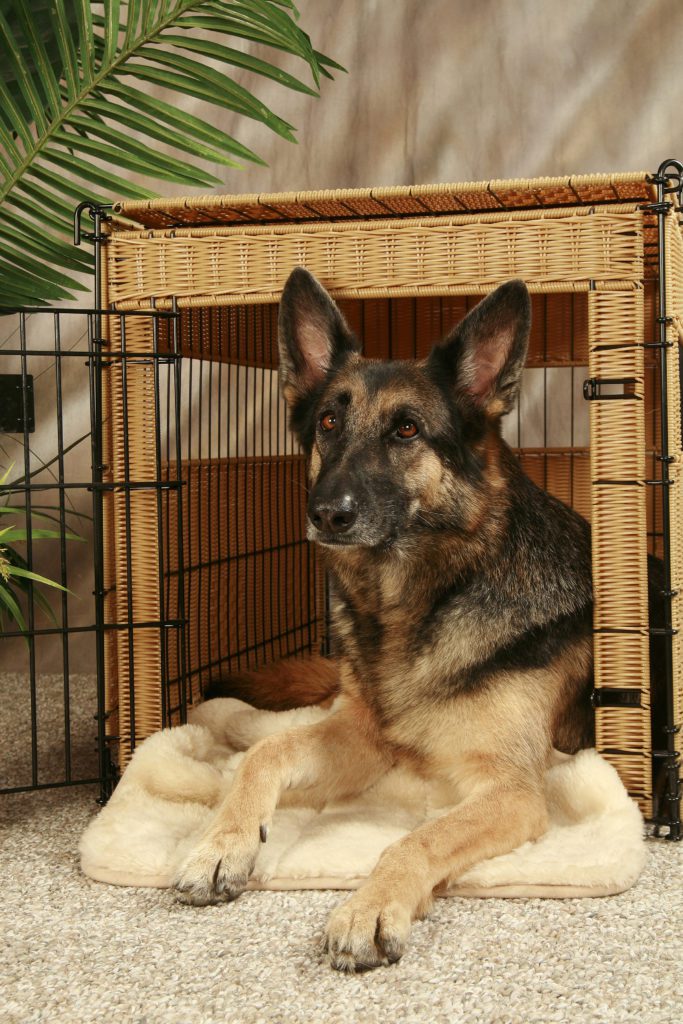
To crate or not to crate. For many dog owners, that is the question – but the answer is clouded in confusion and controversy. Are crates safe? Or do they present a danger to my pet? Will it make her feel secure? Or will it feel like punishment? The answer to all these concerns: It depends. On what? You! With proper training, crates can be a safe, effective part of your dog’s training.
Wait, Before You Crate: Is Crate Training Right for Your Dog?
There’s no such thing as a one-dog-fits-all approach to training. While crates do work well for a lot of dogs, there are some situations in which it may do more harm than good. If you’re confident that crate training is right for your dog, read on!
Crate Training: Creating a Den Just for Your Dog
Step 1: Choose your crate
The two most common types of crates are plastic (very durable and private) and metal (collapsible, easy to store, and airy). Choose the option that works best for your dog and your specific needs.
What about size? Your dog needs just enough room to stand up and turn around. This discourages her from creating an en-suite bathroom in the crate.
Step 2: Decorate!
Make a space in which your dog will feel comfortable and secure. Inside, place a soft blanket or towel, along with a few toys; then position the crate somewhere where you spend a lot of time. This way she’s still “part of the action.”
Step 3: Familiarize your dog with the crate.
The key to training your dog to do anything – from taking a bath to walking nicely on a leash – is practice, praise, and treats. The goal is to teach her to associate these things with pleasure.
On the day before you start your crate training mission, leave the crate door open. When she’s not looking, throw a few of her favorite treats in and around the crate – then let her find them on her own. Do this over the next few weeks; you won’t be able to get her out of the crate!
Mealtimes are an excellent way to reinforce the association between crate and pleasure. Put her bowl in and leave the door open. At first, position it in the back so she has to enter the crate to eat. If she’s fearful or hesitant, slide it to the front. As she becomes more accustomed to the crate, you can slide it back progressively.
Step 4:
Sit near the crate – and whatever you do, do not forget the treats! Choose a cue (“Go to bed.” “Bed.” “Room.”). It doesn’t matter what it is, only that you use it consistently. Toss a treat into the crate. She’ll likely go in and get it. When she does, praise her and give her another treat while she’s inside. (Don’t worry; she’ll burn off all those treat calories on her next walk!)
Say “Ok,” when it’s time for her to come out. Don’t give her a treat then. Why? Because good things happen when she goes into the crate.
Repeat this step several times. Take a few minutes for a break, and then do several more repetitions.
Step 5:
A few hours later, it’s time for more training. The difference in this session is that you’ll ask her to go into the crate before giving her the treat. Warm up by tossing a treat inside and praising your dog when she goes in to get it. Do this a few times.
Next, give your cue to go to bed. Do not put a treat in. Just point to the crate. When she’s in, praise her and give her treats while she’s in the crate. Tell her “Ok,” when it’s time to come out. Again, do this several times and take a short break. Repeat it several more times. At this point, your dog should know how to enter and exit on command. If not, practice a few more times!
Step 6: Close the door
Start another training session a few hours later. Begin by practicing with your cue, pointing to the crate, and giving your dog a treat. When she’s got it down, cue your dog to the crate, give her a treat, and then close the door. While she’s in there, feed her a few more treats and praise her.
Say “Ok,” and open the door. Most dogs will be perfectly fine during this process – and they’ll love all the attention and yumminess. If your pooch is scared, though, back up. Start by closing the door halfway and work your way up.
Repeat this exercise several times, take a break, and do another round. Each time, keep the door closed a bit longer. Work up to about 20 seconds during this first session. After that, take a half-hour break. This’ll give you time to stock up on more treats!
Throughout the afternoon, repeat this process. Try to work up to a minute in the crate with the door closed.
Step 7: Leaving – for a Little While!
In the evening, practice step 6 a few times. Then, cue your dog to go to bed. When she is in the crate, close and latch the door, and give her a treat. Stand up and give her another. Take a few steps away – you’re not leaving the room yet. After a few seconds, go back to the crate with, you guessed it, another treat. Say “Ok,” and let her out.
Repeat this several times, walking to different spots in the room. Slowly increase the time your dog stays in the crate. Every few seconds, return and give her a treat. Practice this several more times, then take a good half-hour break. Rested and refreshed, you can practice some more. This time, leave the room for a few seconds. Go back and reward her.
Step 8: R&R in the Crate
The next morning, gather your supplies: a bone or a toy stuffed with peanut butter, a TV, magazine, book, or project (those last items are for you!). Tell your dog to go to the crate. When she does, reward her with praise and that yummy – and long-lasting- treat. Close the door and work on crosswords or the newest episode of Game of Thrones for a half hour.
It’s important that your dog be quiet in the crate. If she’s saying, “Hey, let me outta here!” ignore her. Yes, it can get irritating! When she’s quiet for a few seconds, give her a treat. But do not give in to her and let her out. You could also say, “Too bad” and leave the room. When she’s quiet for about 10 seconds, you can come back in.
Don’t worry: you’re not neglecting your dog. You’re teaching her that quiet earns treats, as does being good in the crate. And she’ll learn very quickly!
After a half hour, open the door and say “Ok.” Take her chew toy or treat away and don’t provide any reward. Don’t make a big deal out of her feat. That’ll teach her the magic happens inside the crate! Wait a few hours and do this again.
Step 9: Alone Time!
In the afternoon, give your dog a vigorous workout. A tired dog is a well-behaved dog! And it’ll give her a chance to eliminate. Repeat step 8, but instead of sitting down to watch Game of Thrones, you’ll leave the room for 10 minutes. If she’s complaining or vocalizing, don’t come back in the room until she’s been quiet for about 10 seconds.
Let her out, give her a break, and then do it again. Throughout the afternoon, repeat this process. Increase the time your pup stays in the crate. If you can, work up a full hour of alone time.
If she can do an hour, she’s well on her way to getting an A+ in crate training. In the evening, cue her to the crate, give her a delicious chew toy or treat and leave the house for 10 minutes. Come back and let her out. Remember to take the chew toy or treat away. Act casually. No big deal; nothing to see here, folks! This helps your dog become more comfortable with the crate.
Repeat this a few more times. Soon, your dog will be ready to be home alone for an hour or two. Gradually increase the time spent in the crate.
When done right, crate training gives your dog a safe, private place to rest and relax. The process isn’t hard – but it does require a lot of repetition and a big investment in treats. When a pet is able to spend quality time in her crate, though, it’s well worth it!
Want to read more? Head over to Labrador Training HQ’s for more crate training information!


